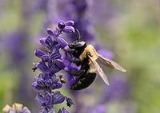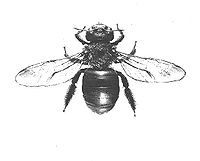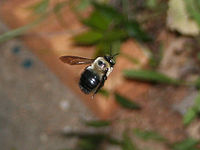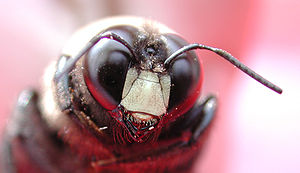
Eastern carpenter bee
Encyclopedia
The common eastern carpenter bee, Xylocopa virginica, is the carpenter bee
most often encountered in the eastern United States
. It is often mistaken for a large bumblebee
species, as they are similar in size and coloring. They can be important pollinator
s, especially of open-faced flowers, though they are also known to "rob
" nectar by boring holes in the sides of flowers with deep corollas (thus not accomplishing pollination). They sometimes bore holes in wood dwellings and can become minor pests. They use chewed wood bits to form partitions between the cells in the nest.

 The most visible physical difference (at a glance) between this species and a bumblebee
The most visible physical difference (at a glance) between this species and a bumblebee
is the abdomen
. Eastern carpenter bees have a shiny black abdomen, with the only yellow hair present being at the base next to the thorax, while bumblebees have a very fuzzy abdomen, which in some species has large areas of yellow hair across the middle (this is visible and obvious). The female eastern carpenter bee also has a much broader head than bumblebees. Eastern carpenter bees can be sexed at a glance. Males have a patch of white cuticle on the face, as opposed to females, whose faces are black. Males are unable to sting, since a bee's stinger is a modified ovipositor
(an egg laying organ).
Males will visit flowers only to feed themselves, spending the rest of the time hovering in their territory and investigating any movement, or guarding flowers where they might encounter females . Females spend the majority of their time gathering nectar and pollen to provision their nests.
 Because of their value as pollinators some people allow carpenter bees to stay around the home in the early spring, living with the cosmetic damage caused. In some fruit growing areas carpenter bee populations are encouraged by supplying them with suitable blocks or boards of soft wood.
Because of their value as pollinators some people allow carpenter bees to stay around the home in the early spring, living with the cosmetic damage caused. In some fruit growing areas carpenter bee populations are encouraged by supplying them with suitable blocks or boards of soft wood.
 In the eastern U.S., Xylocopa virginica overwinter as adults inside the same tunnels where they hatched that summer. In spring, they awaken. The males hover around looking for mates. The female enlarges the existing tunnel, or moves nearby and bores a new tunnel. She creates separate partitions in the tunnel out of sawdust and saliva. She provisions each section with a paste-like wad of pollen and nectar, lays one egg on it, and seals it off. She makes many of these partitioned cells, with as few as 1 and in excess of 20. The egg hatches into a grub-like larva which eats the pollen mass. It then turns into a pupa, which hatches into an adult bee in mid- to late summer. The newly hatched adults break through the partitions and crawl over each other to escape to the outside world. However, they do not then disperse, but continue to live in the tunnel, preparing to hibernate. Thus, the piece of wood is inhabited by bees year-round.
In the eastern U.S., Xylocopa virginica overwinter as adults inside the same tunnels where they hatched that summer. In spring, they awaken. The males hover around looking for mates. The female enlarges the existing tunnel, or moves nearby and bores a new tunnel. She creates separate partitions in the tunnel out of sawdust and saliva. She provisions each section with a paste-like wad of pollen and nectar, lays one egg on it, and seals it off. She makes many of these partitioned cells, with as few as 1 and in excess of 20. The egg hatches into a grub-like larva which eats the pollen mass. It then turns into a pupa, which hatches into an adult bee in mid- to late summer. The newly hatched adults break through the partitions and crawl over each other to escape to the outside world. However, they do not then disperse, but continue to live in the tunnel, preparing to hibernate. Thus, the piece of wood is inhabited by bees year-round.
Rarely, active nests in a home can involve considerable damage, but woodpeckers normally are the primary cause of it, as they search out larval bees.
Carpenter bee nests are rather easy to spot. They bore a highly polished hole about 1 cm in diameter directly up into the bottom a nesting substrate (usually an eave, picnic bench or similar wood structure). When the female is boring tunnels, there is a collection of fresh sawdust below the hole and the sound of boring can be easily heard. One can often see yellowish splashes of waste below the entrance, produced by the bee just as she flies out.
is a serious environmental issue and carpenter bees are being valued increasingly as important pollinators.
Carpenter bees are sometimes dissuaded from making nests in painted or stained wood. Paint is a better deterrent than stain, and bare wood is very inviting to a bee looking for a place to start a new nest. However, X. virginica will nest in almost any soft wood , particularly if it is exposed to the sun. In cases where carpenter bees persist in spite of paint, the edge of the wood can be covered with a narrow strip of flashing or screening, and painted, thus providing a physical barrier.
The eastern carpenter bee is faithful to its home, preferring to lay eggs in the same hole it was born in and hibernated in. Females who leave the natal tunnel prefer to live nearby, often digging a new hole a few inches away in the same piece of wood. Over many years, the bees may almost completely hollow out a single board, or a few boards, without ever touching adjacent pieces. Thus, carpenter bee habitations tend to remain clumped in one area. Because each female produces only a few young bees each year, their numbers grow slowly.
Since previous nests are the primary nests each year, blocking or poisoning nests can often backfire on the homeowner, by encouraging the carpenter bee to bore new nests. Over time the burrowing of these new holes may weaken structures.
An alternative means of preventing nesting in valuable wood is to attract the bees to another location by propping a beam of attractive bare wood where you would prefer the bees to stay. The theory is that the bees will build their nests in the wood you supply for them and stay away from your house. Often, an old wooden shed or barn sustains a population of carpenter bees.
Male eastern carpenter bees are curious and will investigate anyone, including humans, that comes near their nests. The curiosity is often interpreted as aggressiveness; however, the males are only aggressive to other male carpenter bees. They do not have stingers and cannot cause any real harm. The female carpenter bees tend to be busy with floral visitation and nest provisioning, but have the ability to cause a painful sting if captured.
Males spend many hours guarding their territory against other males, hovering about the nests for hours on sunny days. They sometimes attempt to mate with other insects or small birds.
An interesting trick to use to "move" a male carpenter bee out of the way is to pick up a small pebble (roughly the size of the bee), then toss it past the bee. They will attempt to chase it, distracting them for a few moments, long enough for a human to get by. However, since they cannot sting, and rarely accord any attention to humans, this is unnecessary.
Carpenter bees are strong fliers, capable of returning to their nests from some miles away, but not very agile. They tend to be clumsy, frequently almost crashing into the side of a wall or various trees and plants. On occasions, the bees will fly into old windows made of acrylic glass
, as UV light can pass through it and the bee sees it as open.
Carpenter bees are not aggressive. Often, a carpenter bee preoccupied with something will not sting or flee when approached closely or even touched by a human, but merely raise one or two of its legs in the air instead.
Carpenter bee
Carpenter bees are large, hairy bees distributed worldwide. There are some 500 species of carpenter bee in 31 subgenera...
most often encountered in the eastern United States
United States
The United States of America is a federal constitutional republic comprising fifty states and a federal district...
. It is often mistaken for a large bumblebee
Bumblebee
A bumble bee is any member of the bee genus Bombus, in the family Apidae. There are over 250 known species, existing primarily in the Northern Hemisphere although they are common in New Zealand and in the Australian state of Tasmania.Bumble bees are social insects that are characterised by black...
species, as they are similar in size and coloring. They can be important pollinator
Pollinator
A pollinator is the biotic agent that moves pollen from the male anthers of a flower to the female stigma of a flower to accomplish fertilization or syngamy of the female gamete in the ovule of the flower by the male gamete from the pollen grain...
s, especially of open-faced flowers, though they are also known to "rob
Nectar robbing
Nectar robbing refers to the act by an animal, typically an insect or a bird, of removing nectar from a flowering plant, most often by drilling a hole in the corolla. In this way animals without morphological adaptations required by the structure of the flower may access nectar...
" nectar by boring holes in the sides of flowers with deep corollas (thus not accomplishing pollination). They sometimes bore holes in wood dwellings and can become minor pests. They use chewed wood bits to form partitions between the cells in the nest.
Appearance


Bumblebee
A bumble bee is any member of the bee genus Bombus, in the family Apidae. There are over 250 known species, existing primarily in the Northern Hemisphere although they are common in New Zealand and in the Australian state of Tasmania.Bumble bees are social insects that are characterised by black...
is the abdomen
Abdomen
In vertebrates such as mammals the abdomen constitutes the part of the body between the thorax and pelvis. The region enclosed by the abdomen is termed the abdominal cavity...
. Eastern carpenter bees have a shiny black abdomen, with the only yellow hair present being at the base next to the thorax, while bumblebees have a very fuzzy abdomen, which in some species has large areas of yellow hair across the middle (this is visible and obvious). The female eastern carpenter bee also has a much broader head than bumblebees. Eastern carpenter bees can be sexed at a glance. Males have a patch of white cuticle on the face, as opposed to females, whose faces are black. Males are unable to sting, since a bee's stinger is a modified ovipositor
Ovipositor
The ovipositor is an organ used by some animals for oviposition, i.e., the laying of eggs. It consists of a maximum of three pairs of appendages formed to transmit the egg, to prepare a place for it, and to place it properly...
(an egg laying organ).
Nesting
Female carpenter bees make nests by tunneling into wood. They make an initial upward hole in an overhang, eaves trough, or similar structure. Then, they make one or more horizontal tunnels. The final nest usually resembles a T. Unlike termites, carpenter bees (also called woodcutters) do not eat wood. They discard the bits of wood, or use them to make partitions (walls) inside the tunnels of their nests. The tunnel functions as a nursery for brood and the pollen/nectar upon which the brood subsists.Males will visit flowers only to feed themselves, spending the rest of the time hovering in their territory and investigating any movement, or guarding flowers where they might encounter females . Females spend the majority of their time gathering nectar and pollen to provision their nests.


Rarely, active nests in a home can involve considerable damage, but woodpeckers normally are the primary cause of it, as they search out larval bees.
Carpenter bee nests are rather easy to spot. They bore a highly polished hole about 1 cm in diameter directly up into the bottom a nesting substrate (usually an eave, picnic bench or similar wood structure). When the female is boring tunnels, there is a collection of fresh sawdust below the hole and the sound of boring can be easily heard. One can often see yellowish splashes of waste below the entrance, produced by the bee just as she flies out.
Deterrence
Pollinator declinePollinator decline
The term pollinator decline refers to the reduction in abundance of pollinators in many ecosystems worldwide during the end of the twentieth century....
is a serious environmental issue and carpenter bees are being valued increasingly as important pollinators.
Carpenter bees are sometimes dissuaded from making nests in painted or stained wood. Paint is a better deterrent than stain, and bare wood is very inviting to a bee looking for a place to start a new nest. However, X. virginica will nest in almost any soft wood , particularly if it is exposed to the sun. In cases where carpenter bees persist in spite of paint, the edge of the wood can be covered with a narrow strip of flashing or screening, and painted, thus providing a physical barrier.
The eastern carpenter bee is faithful to its home, preferring to lay eggs in the same hole it was born in and hibernated in. Females who leave the natal tunnel prefer to live nearby, often digging a new hole a few inches away in the same piece of wood. Over many years, the bees may almost completely hollow out a single board, or a few boards, without ever touching adjacent pieces. Thus, carpenter bee habitations tend to remain clumped in one area. Because each female produces only a few young bees each year, their numbers grow slowly.
Since previous nests are the primary nests each year, blocking or poisoning nests can often backfire on the homeowner, by encouraging the carpenter bee to bore new nests. Over time the burrowing of these new holes may weaken structures.
An alternative means of preventing nesting in valuable wood is to attract the bees to another location by propping a beam of attractive bare wood where you would prefer the bees to stay. The theory is that the bees will build their nests in the wood you supply for them and stay away from your house. Often, an old wooden shed or barn sustains a population of carpenter bees.
Behavior
Carpenter bees are not solitary bees, but are not truly social either. The weak form of sociality they exhibit, with one female doing the majority of the work, and caring for her sisters, may be a transitional step in the evolution of sociality. However they tend to be gregarious, and often several will nest near each other.Male eastern carpenter bees are curious and will investigate anyone, including humans, that comes near their nests. The curiosity is often interpreted as aggressiveness; however, the males are only aggressive to other male carpenter bees. They do not have stingers and cannot cause any real harm. The female carpenter bees tend to be busy with floral visitation and nest provisioning, but have the ability to cause a painful sting if captured.
Males spend many hours guarding their territory against other males, hovering about the nests for hours on sunny days. They sometimes attempt to mate with other insects or small birds.
An interesting trick to use to "move" a male carpenter bee out of the way is to pick up a small pebble (roughly the size of the bee), then toss it past the bee. They will attempt to chase it, distracting them for a few moments, long enough for a human to get by. However, since they cannot sting, and rarely accord any attention to humans, this is unnecessary.
Carpenter bees are strong fliers, capable of returning to their nests from some miles away, but not very agile. They tend to be clumsy, frequently almost crashing into the side of a wall or various trees and plants. On occasions, the bees will fly into old windows made of acrylic glass
Acrylic glass
Poly is a transparent thermoplastic, often used as a light or shatter-resistant alternative to glass. It is sometimes called acrylic glass. Chemically, it is the synthetic polymer of methyl methacrylate...
, as UV light can pass through it and the bee sees it as open.
Carpenter bees are not aggressive. Often, a carpenter bee preoccupied with something will not sting or flee when approached closely or even touched by a human, but merely raise one or two of its legs in the air instead.
Further reading
- Mitchell, Theodore B. (1962): Bees of the Eastern United States. Vol. II, The North Carolina Agricultural Experiment Station, Tech. Bul. No.152, pp. 557 (p. 507 ff)
- Balduf WV, 1962. Life of the carpenter bee, Xylocopa virginica (Linn.) (Xylocopidae, Hymenoptera). Annals of the Entomological Society of America 55:263-271.
- Barrows EM, 1983. Male Territoriality in the Carpenter Bee Xylocopa virginica. Animal BehaviourAnimal Behaviour (journal)Animal Behaviour is a double-blind peer-reviewed scientific journal established in 1953 as The British Journal of Animal Behaviour, before obtaining its current title in 1958...
31: 806-813. - Barthell JF, Baird TA, 2004. Size variation and Aggression among Male Xylocopa virginica (L.) (Hymenoptera: Apidae) at a Nesting Site in Central Oklahoma. Journal of the Kansas Entomological SocietyJournal of the Kansas Entomological SocietyThe Journal of the Kansas Entomological Society is a quarterly peer-reviewed scientific journal published by the Kansas Entomological Society. The journal has a 2009 impact factor of 0.607....
77:10-20. - Gerling D, Hermann HR, 1976. Biology and Mating Behavior of Xylocopa virginica L. (Hymenoptera, Anthrophoridae). Behavioral Ecology and SociobiologyBehavioral Ecology and SociobiologyBehavioral Ecology and Sociobiology is a peer-reviewed scientific journal covering quantitative, empirical, and theoretical studies in the field of analysis of animal behavior at the levels of the individual, population, and community....
3:99-111. - Sabrosky CW, 1962. Mating in Xylocopa virginica. Proceedings of the Entomological Society of America 64:184.

